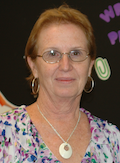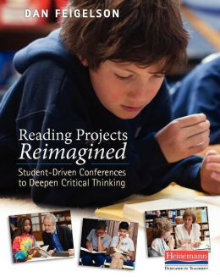How We Can Reimagine Student Reading Projects
Reading Projects Reimagined: Student-Driven Conferences to Deepen Critical Thinking
By Dan Feigelson
(Heinemann, 2015 – Learn more)
 Reviewed by Linda Biondi
Reviewed by Linda Biondi
When I first read the title, Reading Projects Reimagined: Student-Driven Conferences to Deepen Critical Thinking, I thought that’s a really long title for a book. Then I envisioned what I remembered about reading projects: shoe box dioramas, five paragraph essays, posters, and meaningless projects. Whew! I truly hoped that this wasn’t a prescription book of arts and crafts projects.
 I breathed a sigh of relief as I read further. This book is about collaboration – “conference based reading projects are worked together with teacher and student after conferring over a period of time to create an assignment that extends and challenges their thinking.” So conference based reading projects help students with comprehension. I was excited to read more.
I breathed a sigh of relief as I read further. This book is about collaboration – “conference based reading projects are worked together with teacher and student after conferring over a period of time to create an assignment that extends and challenges their thinking.” So conference based reading projects help students with comprehension. I was excited to read more.
Reading Projects Reimagined is expertly written by Dan Feigelson, who has experience as a teacher, staff developer, curriculum writer, principal, and local superintendent. He truly is a man who has worn and continues to wear many hats. Dan is also the author of Practical Punctuation: Lessons in Rule Making and Rule Breaking in Elementary Writing (another long title!).
Before I started to read the book, I wasn’t sure what to expect. Would I be able to use these ideas in my classroom? Would I be able to use it as a supplement to my curriculum? Just how applicable would this book be?
However, from the beginning, I was impressed with Feigelson’s honesty. In the Introduction he cautioned that this book was not meant to replace an existing curriculum but to challenge educators to reflect on how they could find a balance between whole-class work and individual assignments. I was intrigued, wondering what I was missing in my conferring.
Get students thinking
I wholeheartedly agree with Feigelson’s premise that our students need to become more responsible learners. Woven through the pages was the ever present message that we need to give our students opportunities to think for themselves and to realize that they can and should generate valid ideas on their own. We want them to become sophisticated thinkers who can analyze a piece of text and explain their thinking.
These words meant a great deal to me. I want my students to be able to push their thinking to a new level. I want them to be able to support their ideas and to think critically.
What’s new
The obvious question to me was what the difference between conference-based reading projects and the traditional conferences. I knew what traditional conferences were. They were a part of my daily literacy regime. I confer, take notes, and build lessons on my students’ needs based on my conferring notes. As I continued to read, I learned that conference-based reading projects are done in steps (p. 7-8):
- Notice something in the text you find interesting and talk about it, such as what a character is like or what she/he does.
- Keep track of this as you read and see how your idea grows or changes, using sticky notes, reading notebooks, annotations, organizers.
- Look back and record your thinking and sum it up by writing a few sentences and looking at your sticky notes, then discuss which ones fit together.
- Make a diagram or graphic organizer.
Student driven conferences
Did you ever feel like your students could or should be doing more? Are their sticky notes just jots without meaningful connections or elaboration? The book’s basic guidelines helped me to take my conferring to a new level as well. As I looked through my students’ Readers Notebooks, I stepped back to see how this book could help me guide them to become better readers. I realized that by following these easy-to-implement steps, students will be able to synthesize supporting evidence as they read instead of producing a hodgepodge of Post Its that vaguely complement each other. By shifting the focus to the student reading and student driven conferences, they will begin to focus on a specific ideas and delve deeper into meaning and thought.
Following conference conversations
Feigelson’s book is a study in thinking and conferring. For example, through authentic diary entries, the reader follows the progress of a student, Katerina, from September to February as she conferences with her teacher, Jamie Kushner, at the Manhattan New School. Feigelson succinctly gives you a glimpse into what is happening in the classroom along with conference notes and student work.
By listening in on the conversations between the teachers and students throughout the book, I was able to get a glimpse of the classroom and the interactions. I could hear the teacher speaking, and honestly, I could envision the student’s response. Through the conference based projects, I could glimpse into the student’s mind as they thought through what they were working on and how to challenge their thinking.
Umbrella categories
But you may say, “Of course theory is fine, but what about the practicality?” Guess what! Dan read your mind. One chapter is devoted to “Umbrella Categories: Types of Reading Conferences and Sample Projects.” Nine “umbrella categories” are described with examples of sample teaching points described in kid-friendly language. Possible reading projects accompany each category. He groups the nine categories into two types: Metacognive reading conferences and text-based conferences.
Teachers love to share and Feigelson continues to share. Chapter Five is devoted to “Go-to Conferences,” a repertoire of conferences that were created by teachers. Included are the transcripts, teaching points, a possible future conference, and projects. It’s important to note that in these conferences, the teacher sets up the reading and thinking stage, but the students do the work. By using this strategy the teacher will see the student expand their thinking in the next conference.
The book shows us what we want to see: the student taking the reins. It is a book for educators in a variety of roles – teachers, coaches, administration, and professional development groups.
Linda Biondi is a fourth grade teacher at Pond Road Middle School in Robbinsville, NJ, and a long-time Morning Meeting practitioner. She’s also the recipient of several educational grants, a Teacher Consultant with the National Writing Project and a participant on the NJ Department of Education Teacher Advisory Panel. Linda participates in ECET2 Celebrate Teaching which recently posted an interview with her.

































